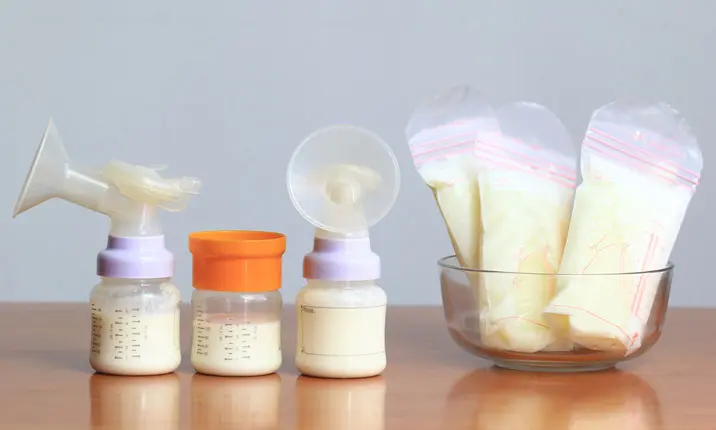

Source: Shutterstock
How to Breastfeed Successfully?
Last updated: Tuesday, July 2, 2019 | 7 min reading time
The first week with your newborn can be exciting but also daunting, especially for first-time mothers. Here are some tips on how to make your breastfeeding journey a little easier.
1. When will my breast milk come in?
Your body starts to produce breast milk before your baby is born. Within an hour of the birth, your baby will be able to take their first feed. Your body initially produces a thick yellow substance called colostrum, which contains the necessary nutrients to nourish your baby and prepare their digestive systems for future feeds. After a few days, your body will start producing the breast milk that sustains your baby as they grow, which is thinner than colostrum and is pale white or cream in colour.
2. Can I breastfeed after a caesarean?
It is a myth that a caesarean section prevents a mother from breastfeeding. However, you may need to adopt specific positions that don't put pressure on your incision. Your nurse or doctor can show you how to use a pillow to support the baby and protect your stitches as they heal.
Did you know?
Mount Elizabeth Orchard and Mount Elizabeth Novena Hospital are the first two private hospitals to be accredited as baby-friendly by the World Health Organisation's (WHO) Baby Friendly Health Initiative (BFHI).
The criteria for this certification includes a commitment to 10 steps to encourage breastfeeding, such as facilitating skin-to-skin contact between mother and baby for at least one hour immediately after delivery.
3. How often should I breastfeed?
Breastfed babies usually eat between 8 – 12 times within 24 hours. That equates to a feed every couple of hours and preferably with at least 1 night feed because mothers produce more prolactin (the hormone that promotes milk production) at night. As your baby grows, the frequency of the feeds will decrease and your baby will become more efficient at getting the milk they need. You can follow your baby's lead with your schedule. If they are nuzzling against you, opening their mouth, making sucking noises, or simply crying, they probably need a feed.
4. How long should a breastfeeding session take?
The duration of a breastfeeding session varies between 10 – 45 minutes. If your baby is only nursing for 10 minutes at a time, they might not be getting enough. You could try repositioning or correcting the latch to get your baby to take more. Many women switch breasts mid-feed, but it’s important to make sure the first breast is drained before changing over. That way, your baby gets the foremilk and the hindmilk, which have different and essential properties for healthy growth.
5. How can I tell if my baby is latching correctly?
A correct latch should feel comfortable and never painful. Breastfeeding is very quiet when your baby is latched properly. Start latching with your baby's mouth wide open and lower lip pointing outwards. Make sure that your baby's chin is touching your breast (or nearly so), and the bottom of your areola should be completely covered, leaving a smaller part of it visible above your baby's mouth. If you can hear a smacking noise, or very loud sucking, there may be too much air getting in. Your baby's lips should be full and if it doesn't feel right, unlatch your baby and try again.
6. What is let-down?
The let-down reflex is the process where milk begins to flow from your milk ducts. For the first few days, when your baby latches, the let-down may take a little while to occur. As you get used to breastfeeding it can happen very quickly. Some women find the let-down causes a tingling sensation. Hearing a baby cry, or thinking about your baby can sometimes trigger it, so you may want to wear pads in your bra to prevent leakage throughout the day.
7. Does breastfeeding hurt?
Breastfeeding shouldn't hurt, although cracked nipples are a common problem and can cause minor tenderness. You can use your own breast milk or a healing balm to help them recover. However, if you are experiencing severe pain, a fever, red shiny breasts, or flu-like symptoms, speak to your doctor. An infection called mastitis might be the culprit, and it should be treated as soon as possible.
8. How do I know if my baby is getting enough milk?
Without using bottles to measure the intake, it can be hard to know exactly how much milk your baby is getting. The best way to monitor this is your baby's weight and number of wet nappies. After the first week, your baby should have between 6 – 10 heavy wet nappies a day. Your paediatrician will track your baby's weight and if they gain an appropriate amount each week you can assume their milk intake is enough.
9. How do I improve my milk supply?
Nurse whenever your baby wants to be fed. Breast milk is produced by demand, so the more your baby feeds, the more you produce. Try to get plenty of rest, and relax, because stress can hinder your supply. Consume a fresh, balanced diet, and stay hydrated. If you take medication, talk to your doctor about the effect it can have on your breast milk production.
10. How long should I keep breastfeeding for?
How long you breastfeed your baby is a personal choice. Breastfeeding for the first few weeks or months is a great way to give your baby a healthy start and a strong immune system. However, you can continue to breastfeed well into your child's toddler years if you wish, and your breast milk will adapt and change to suit your child's developmental stage. The World Health Organisation recommends all mothers to breastfeed exclusively for the first 6 months and continue till babies are 2 years old or beyond.
11. Should I prepare formula as well?
Some mothers feed their baby with a mixture of breast milk and formula. There could be a number of reasons for doing so, but it does offer a little more flexibility if you need to return to work or take a break. Pumping is an option too, but whatever combination you decide on, it should be your decision. Keeping a regular routine of breast milk and formula sessions will help prevent any nipple confusion for your baby.
12. If I intend to exclusively breastfeed, can I still use a bottle or pacifier if I need to?
There is a risk of nipple confusion when switching between bottles, pacifiers and breastfeeding. This is when your baby starts to refuse feeds because the feel and texture of the nipple or teat keeps changing. You should establish breastfeeding for the first 4 weeks if possible before trying to introduce anything else. Forcing a bottle or pacifier on your baby too early may affect your breastfeeding relationship.
13. What are the benefits of breastfeeding?
Breastfeeding has many benefits. Breast milk is a living substance that adapts to your baby's needs, so if they or you are sick, the breast milk can deliver essential antibodies to fight the illness. It evolves and changes to suit each developmental stage, and is the most affordable way of feeding your baby. The benefits of breastfeeding for mother and child include:
Mother
- Burns extra calories, and aids weight loss
- Early sucking helps your womb contract faster and reduces blood loss after child birth
- Exclusive breastfeeding in the first 6 months is 98 – 99.5% effective in preventing pregnancy
- Delays the return of your menstrual period
- Promotes mother and child bonding
- Reduces the risk of ovarian and breast cancer
- Reduces the risk of osteoporosis
Baby
- Easily digested and is less likely to cause stomach upset, constipation or diarrhoea
- Provides the best nutrition for your baby's growth and development especially in the first 6 months
- Reduces the incidence of coughs and colds, bronchitis, pneumonia and meningitis
- Protects baby from asthma, eczema and allergies
- Provides optimal physical, emotional and intellectual development of baby
14. Are there reasons I shouldn't breastfeed?
Breastfeeding is a very personal experience and it should always be your choice. Sometimes formula feeding is a better option because it offers more flexibility and the other parent can take over some of the feeds. Some mothers are prone to infections and recurring mastitis, and find breastfeeding too painful. Others simply don't enjoy the experience. The best choice for you and your family should be whatever makes you the happiest.
If you have more questions about breastfeeding, make an appointment with your lactation consultant.
Bouchez, C. (2006, August 28) Breastfeeding Basics. Retrieved 11/06/19 from https://www.webmd.com/parenting/baby/features/breastbreastfeeding_basics#1
Bouchez, C. (ND) Getting on a Breastfeeding Schedule. Retrieved 11/06/2019 from https://www.webmd.com/parenting/baby/features/establish-a-breastfeeding-schedule#4
Brennan, D. (2017, July 27) Breast vs Bottle for your Baby. Retrieved 11/06/2019 from https://www.webmd.com/parenting/baby/your-babys-feeding-breast-vs-bottle
Holland, K. (2019, April 30) Guide to Breastfeeding. Retrieved 11/06/2019 from https://www.healthline.com/health/parenting/breastfeeding
Matthiessen, C. (2014, January 3) Breastfeeding: Get the support you need. Retrieved 11/06/2019 from https://www.webmd.com/parenting/baby/features/breast-feeding-tips#1
What To Expect if You Have a Caesarean Delivery. (ND) Retrieved 11/06/2019 from https://www.webmd.com/baby/features/what-to-expect-cesarean-delivery#2
Bouchez, C. (ND) Getting on a Breastfeeding Schedule. Retrieved 11/06/2019 from https://www.webmd.com/parenting/baby/features/establish-a-breastfeeding-schedule#4
Brennan, D. (2017, July 27) Breast vs Bottle for your Baby. Retrieved 11/06/2019 from https://www.webmd.com/parenting/baby/your-babys-feeding-breast-vs-bottle
Holland, K. (2019, April 30) Guide to Breastfeeding. Retrieved 11/06/2019 from https://www.healthline.com/health/parenting/breastfeeding
Matthiessen, C. (2014, January 3) Breastfeeding: Get the support you need. Retrieved 11/06/2019 from https://www.webmd.com/parenting/baby/features/breast-feeding-tips#1
What To Expect if You Have a Caesarean Delivery. (ND) Retrieved 11/06/2019 from https://www.webmd.com/baby/features/what-to-expect-cesarean-delivery#2
 Brain & Spine Care
Brain & Spine Care











